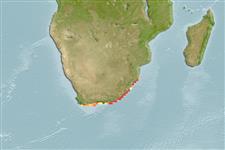>
Centrarchiformes (Basses) >
Latridae (Trumpeters)
Etymology: Chirodactylus: Greek, cheir = hand + Greek, daktylos = finger (Ref. 45335); for the long, unbranched lower pectoral fin rays (Ref. 120445).
Environment: milieu / climate zone / depth range / distribution range
Ökologie
seewasser riff-verbunden; tiefenbereich 3 - 20 m (Ref. 5319). Subtropical; 28°S - 35°S
Western Indian Ocean: South Africa.
Size / Gewicht / Alter
Maturity: Lm ? range ? - ? cm
Max length : 50.0 cm TL Männchen/unbestimmt; (Ref. 5319); common length : 30.0 cm TL Männchen/unbestimmt; (Ref. 9492)
Rückenflossenstacheln (insgesamt): 17 - 18; Rückenflossenweichstrahlen (insgesamt): 26-27; Afterflossenstacheln 3; Afterflossenweichstrahlen: 7 - 8. Scarlet in color with a red-black blotch at pectoral base.
Inhabits coastal waters from the shore line to at least 20 m depth (Ref. 9492). Prefers rocky banks (Ref. 12484). Diurnal (Ref. 12484). Feeds mainly on small, benthic invertebrates (marine worms, crabs and mollusks), but also squid and small fish (Ref. 12484). Mainly caught with spears (Ref. 9492). Marketed fresh, whole (Ref. 9492).
Life cycle and mating behavior
Geschlechtsreife | Fortpflanzung | Ablaichen | Eier | Fecundity | Larven
Smith, M.M., 1986. Cheilodactylidae. p. 667-668. In M.M. Smith and P.C. Heemstra (eds.) Smiths' sea fishes. Springer-Verlag, Berlin. (Ref. 5319)
IUCN Rote Liste Status (Ref. 130435)
Bedrohung für Menschen
Harmless
Nutzung durch Menschen
Fischereien: weniger kommerziell; Sportfisch: ja
Mehr Information
NamenSynonymeMetabolismusRäuberÖkotoxikologieFortpflanzungGeschlechtsreifeAblaichenSpawning aggregationFecundityEierEientwicklung
ReferenzenAquakulturAquakultur ProfilZuchtlinienGenetikElectrophoresesVererbbarkeitKrankheitenVerarbeitungNutrientsMass conversion
PartnerBilderStamps, Coins Misc.LauteCiguateraGeschwindigkeitSchwimmstilKiemenoberflächeOtolithsGehirngrößeSehfähigkeit
Tools
Zusatzinformationen
Download XML
Internet Quellen
Estimates based on models
Preferred temperature (Ref.
123201): 18.6 - 23.9, mean 21.9 °C (based on 40 cells).
Phylogenetic diversity index (Ref.
82804): PD
50 = 0.6250 [Uniqueness, from 0.5 = low to 2.0 = high].
Bayesian length-weight: a=0.01175 (0.00560 - 0.02463), b=3.04 (2.86 - 3.22), in cm total length, based on LWR estimates for this (Sub)family-body shape (Ref.
93245).
Trophic level (Ref.
69278): 3.8 ±0.53 se; based on food items.
Widerstandsfähigkeit (Ref.
120179): mittel, Verdopplung der Population dauert 1,4 - 4,4 Jahre. (Preliminary K or Fecundity.).
Fishing Vulnerability (Ref.
59153): Moderate vulnerability (40 of 100).
